LCCB4005: Global Business Environment - Environmental Analysis Report
VerifiedAdded on 2022/12/23
|9
|2846
|34
Report
AI Summary
This report provides a comprehensive environmental analysis of Marks and Spencer's within the global business environment, specifically addressing the fashion industry's sustainability challenges. The report begins with an introduction to the industry's environmental impact and the company's role in addressing these concerns. It then undertakes a detailed analysis using SWOT and PESTEL frameworks to assess the company's internal strengths and weaknesses, as well as the external political, economic, social, technological, environmental, and legal factors influencing its operations. The report further explores the competitive landscape using Porter's 5 Forces model and Porter's Value Chain to evaluate the company's competitive advantages. The analysis culminates in recommendations for management, aimed at enhancing the company's sustainability efforts and maintaining a competitive position in the evolving global market.
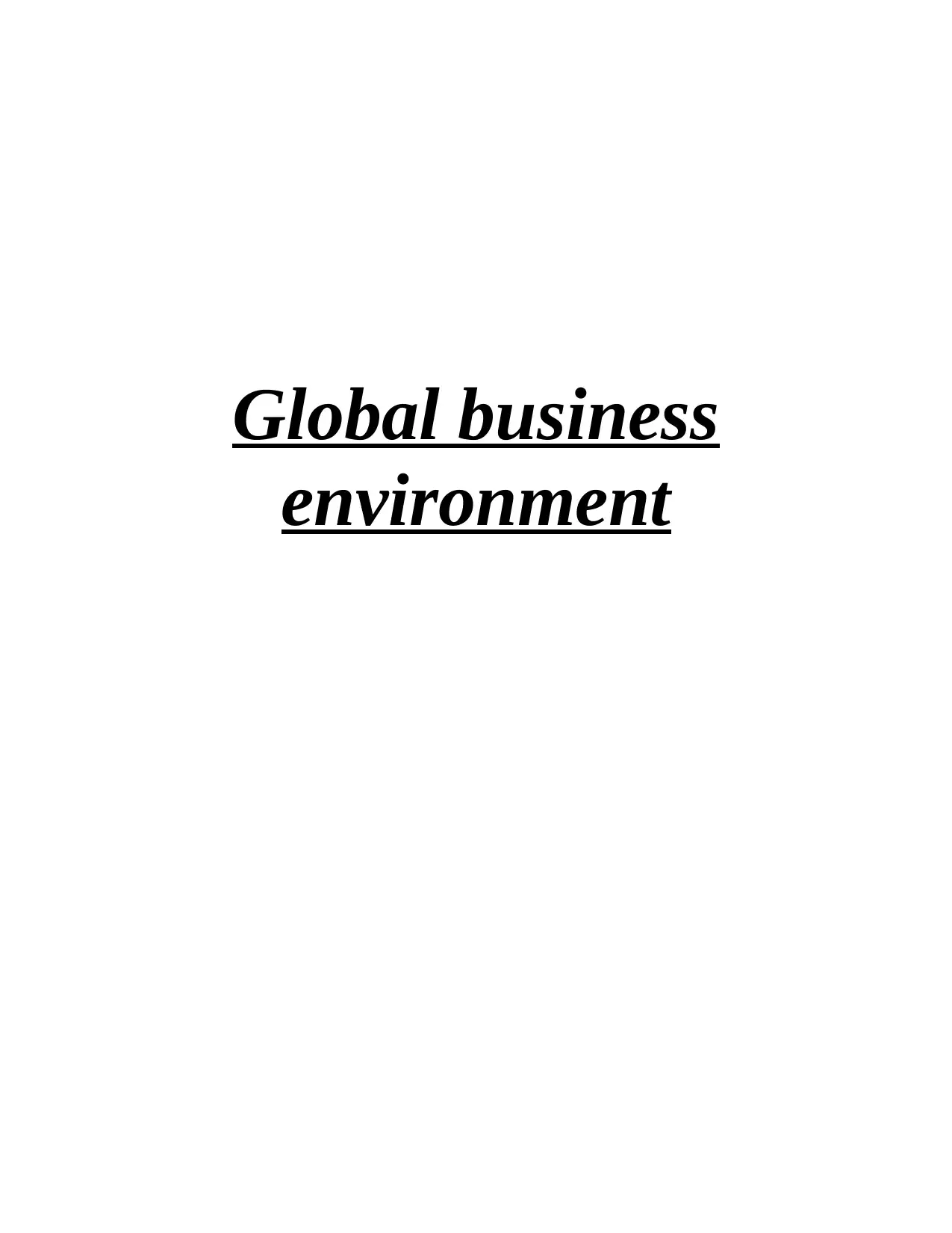
Global business
environment
environment
Paraphrase This Document
Need a fresh take? Get an instant paraphrase of this document with our AI Paraphraser
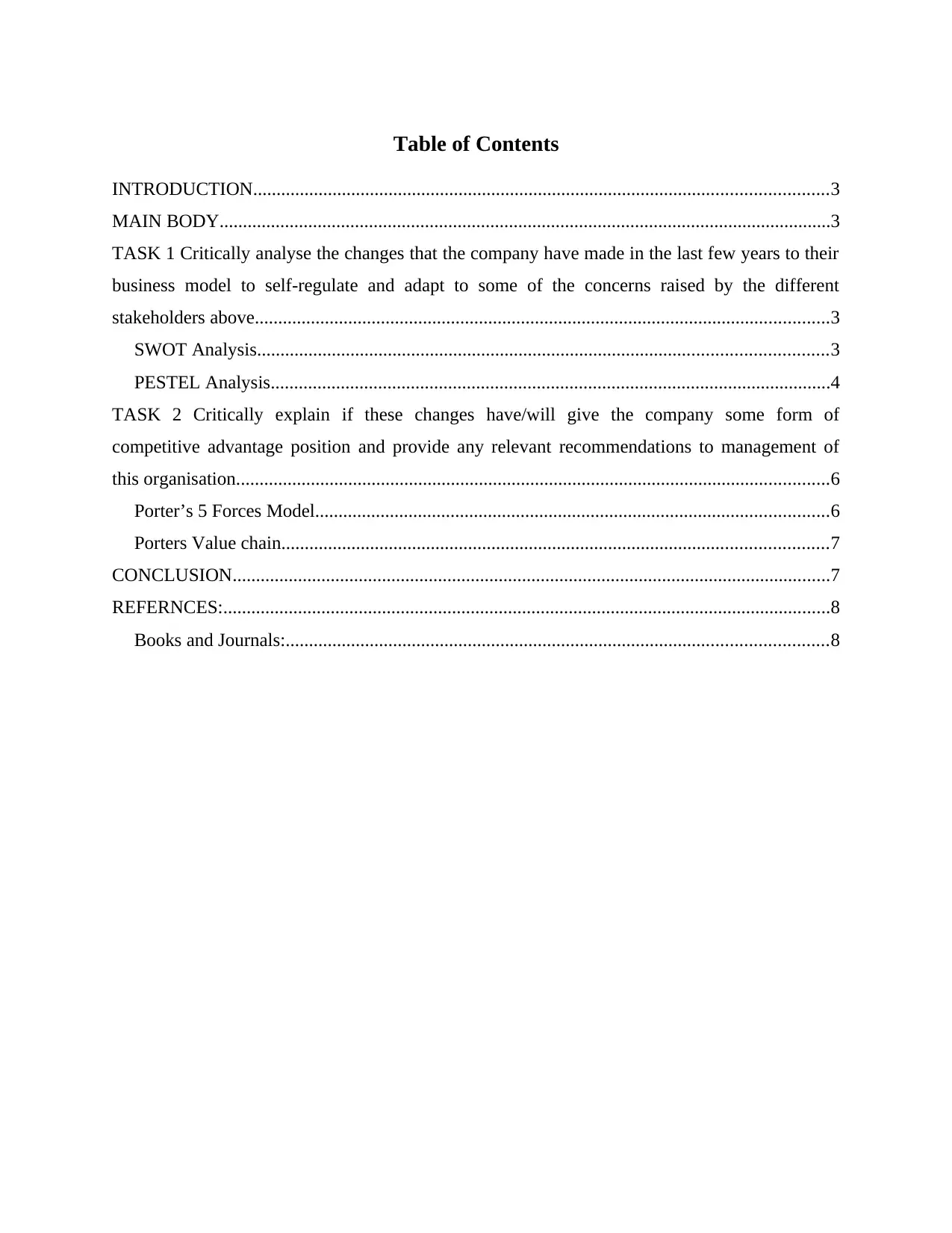
Table of Contents
INTRODUCTION...........................................................................................................................3
MAIN BODY...................................................................................................................................3
TASK 1 Critically analyse the changes that the company have made in the last few years to their
business model to self-regulate and adapt to some of the concerns raised by the different
stakeholders above...........................................................................................................................3
SWOT Analysis..........................................................................................................................3
PESTEL Analysis........................................................................................................................4
TASK 2 Critically explain if these changes have/will give the company some form of
competitive advantage position and provide any relevant recommendations to management of
this organisation...............................................................................................................................6
Porter’s 5 Forces Model..............................................................................................................6
Porters Value chain.....................................................................................................................7
CONCLUSION................................................................................................................................7
REFERNCES:..................................................................................................................................8
Books and Journals:....................................................................................................................8
INTRODUCTION...........................................................................................................................3
MAIN BODY...................................................................................................................................3
TASK 1 Critically analyse the changes that the company have made in the last few years to their
business model to self-regulate and adapt to some of the concerns raised by the different
stakeholders above...........................................................................................................................3
SWOT Analysis..........................................................................................................................3
PESTEL Analysis........................................................................................................................4
TASK 2 Critically explain if these changes have/will give the company some form of
competitive advantage position and provide any relevant recommendations to management of
this organisation...............................................................................................................................6
Porter’s 5 Forces Model..............................................................................................................6
Porters Value chain.....................................................................................................................7
CONCLUSION................................................................................................................................7
REFERNCES:..................................................................................................................................8
Books and Journals:....................................................................................................................8

INTRODUCTION
The fashion industry is considered to be the second largest pollution creating industry in
the whole world. This is because fashion trends are continuously changing which makes people
of the society demand the same. Apart from the pollution in manufacturing, it is also seen that
there been a significant increase in wastage also. As the fashion changes people discard the
outdated clothes. This has caused a high wastage piled up which has resulted in hampering the
sustainability of the economy. In order to manage the waste and bring sustainable development,
organisations are focused on working for the same by determining the factors that affect the
same. The report being studied is carried on the same as which factors and in what manner they
are required to be (Das, and Kundu, 2018) analysed so that situations can be controlled. To this
the organisation being undertaken is Marks and Spencer's whose evaluation is made as how it is
working for pollution management. Marks and Spencer's group plc is a British multinational
organisation that is headquartered in London and is dealing in wide variety of emerging fashion
trends. For this several factors are determined by the help of various tools. The tools studied are
SWOT Analysis, PESTEL Analysis, Porter’s 5 Forces Model, and Porters Value chain that
proves effective in studying the existing conditions in a proper manner.
MAIN BODY
TASK 1 Critically analyse the changes that the company have made in the last
few years to their business model to self-regulate and adapt to some of the
concerns raised by the different stakeholders above.
The changes that company has faced in the previous few years was only possible because
of pre evaluation of determinants and properly following them. They can be studied through
processing SWOT Analysis and PESTEL Analysis.
SWOT Analysis
To determine the internal factors that persuade economy can be studied through
performing SWOT analysis. It studies Strengths, Weakness, Opportunities and Threats which
can be evaluated as:
Strengths: The major strength of fashion industry is that they share a wide market, which
reaches to a wide market. They (Dinçer, Yüksel, and Adalı, 2019) are working on large scale
The fashion industry is considered to be the second largest pollution creating industry in
the whole world. This is because fashion trends are continuously changing which makes people
of the society demand the same. Apart from the pollution in manufacturing, it is also seen that
there been a significant increase in wastage also. As the fashion changes people discard the
outdated clothes. This has caused a high wastage piled up which has resulted in hampering the
sustainability of the economy. In order to manage the waste and bring sustainable development,
organisations are focused on working for the same by determining the factors that affect the
same. The report being studied is carried on the same as which factors and in what manner they
are required to be (Das, and Kundu, 2018) analysed so that situations can be controlled. To this
the organisation being undertaken is Marks and Spencer's whose evaluation is made as how it is
working for pollution management. Marks and Spencer's group plc is a British multinational
organisation that is headquartered in London and is dealing in wide variety of emerging fashion
trends. For this several factors are determined by the help of various tools. The tools studied are
SWOT Analysis, PESTEL Analysis, Porter’s 5 Forces Model, and Porters Value chain that
proves effective in studying the existing conditions in a proper manner.
MAIN BODY
TASK 1 Critically analyse the changes that the company have made in the last
few years to their business model to self-regulate and adapt to some of the
concerns raised by the different stakeholders above.
The changes that company has faced in the previous few years was only possible because
of pre evaluation of determinants and properly following them. They can be studied through
processing SWOT Analysis and PESTEL Analysis.
SWOT Analysis
To determine the internal factors that persuade economy can be studied through
performing SWOT analysis. It studies Strengths, Weakness, Opportunities and Threats which
can be evaluated as:
Strengths: The major strength of fashion industry is that they share a wide market, which
reaches to a wide market. They (Dinçer, Yüksel, and Adalı, 2019) are working on large scale
⊘ This is a preview!⊘
Do you want full access?
Subscribe today to unlock all pages.

Trusted by 1+ million students worldwide
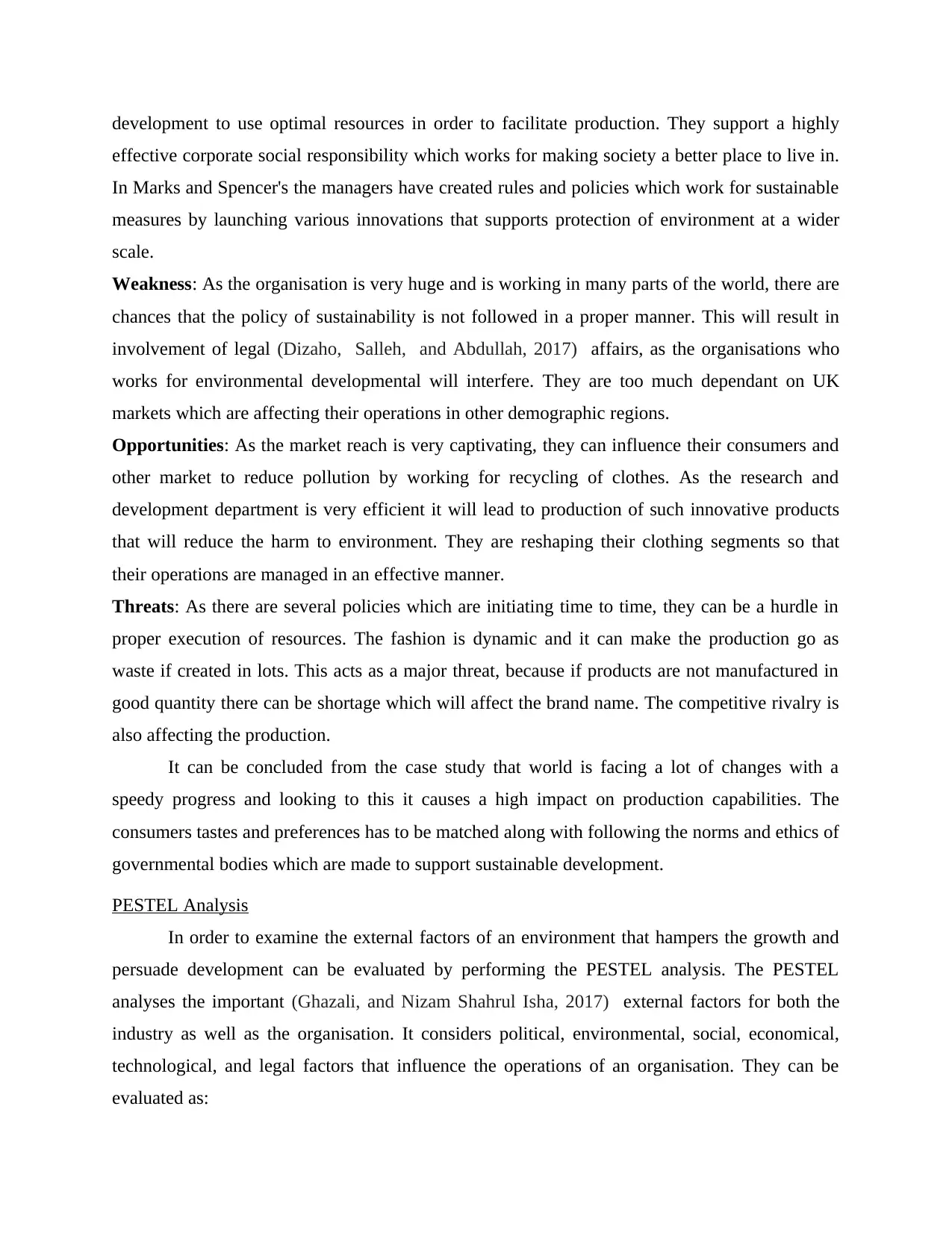
development to use optimal resources in order to facilitate production. They support a highly
effective corporate social responsibility which works for making society a better place to live in.
In Marks and Spencer's the managers have created rules and policies which work for sustainable
measures by launching various innovations that supports protection of environment at a wider
scale.
Weakness: As the organisation is very huge and is working in many parts of the world, there are
chances that the policy of sustainability is not followed in a proper manner. This will result in
involvement of legal (Dizaho, Salleh, and Abdullah, 2017) affairs, as the organisations who
works for environmental developmental will interfere. They are too much dependant on UK
markets which are affecting their operations in other demographic regions.
Opportunities: As the market reach is very captivating, they can influence their consumers and
other market to reduce pollution by working for recycling of clothes. As the research and
development department is very efficient it will lead to production of such innovative products
that will reduce the harm to environment. They are reshaping their clothing segments so that
their operations are managed in an effective manner.
Threats: As there are several policies which are initiating time to time, they can be a hurdle in
proper execution of resources. The fashion is dynamic and it can make the production go as
waste if created in lots. This acts as a major threat, because if products are not manufactured in
good quantity there can be shortage which will affect the brand name. The competitive rivalry is
also affecting the production.
It can be concluded from the case study that world is facing a lot of changes with a
speedy progress and looking to this it causes a high impact on production capabilities. The
consumers tastes and preferences has to be matched along with following the norms and ethics of
governmental bodies which are made to support sustainable development.
PESTEL Analysis
In order to examine the external factors of an environment that hampers the growth and
persuade development can be evaluated by performing the PESTEL analysis. The PESTEL
analyses the important (Ghazali, and Nizam Shahrul Isha, 2017) external factors for both the
industry as well as the organisation. It considers political, environmental, social, economical,
technological, and legal factors that influence the operations of an organisation. They can be
evaluated as:
effective corporate social responsibility which works for making society a better place to live in.
In Marks and Spencer's the managers have created rules and policies which work for sustainable
measures by launching various innovations that supports protection of environment at a wider
scale.
Weakness: As the organisation is very huge and is working in many parts of the world, there are
chances that the policy of sustainability is not followed in a proper manner. This will result in
involvement of legal (Dizaho, Salleh, and Abdullah, 2017) affairs, as the organisations who
works for environmental developmental will interfere. They are too much dependant on UK
markets which are affecting their operations in other demographic regions.
Opportunities: As the market reach is very captivating, they can influence their consumers and
other market to reduce pollution by working for recycling of clothes. As the research and
development department is very efficient it will lead to production of such innovative products
that will reduce the harm to environment. They are reshaping their clothing segments so that
their operations are managed in an effective manner.
Threats: As there are several policies which are initiating time to time, they can be a hurdle in
proper execution of resources. The fashion is dynamic and it can make the production go as
waste if created in lots. This acts as a major threat, because if products are not manufactured in
good quantity there can be shortage which will affect the brand name. The competitive rivalry is
also affecting the production.
It can be concluded from the case study that world is facing a lot of changes with a
speedy progress and looking to this it causes a high impact on production capabilities. The
consumers tastes and preferences has to be matched along with following the norms and ethics of
governmental bodies which are made to support sustainable development.
PESTEL Analysis
In order to examine the external factors of an environment that hampers the growth and
persuade development can be evaluated by performing the PESTEL analysis. The PESTEL
analyses the important (Ghazali, and Nizam Shahrul Isha, 2017) external factors for both the
industry as well as the organisation. It considers political, environmental, social, economical,
technological, and legal factors that influence the operations of an organisation. They can be
evaluated as:
Paraphrase This Document
Need a fresh take? Get an instant paraphrase of this document with our AI Paraphraser

Political Factors: The governmental bodies influence the manufacturers to buy raw materials
and other requirements from the local markets only. This is because it will reduce the taxes and
import duties. There are issues faced by Marks and Spencer's as the raw material available in the
local regions can or cannot be appropriate for the quality which they are producing or want to
purchase. This either increases the cost or makes governmental bodies unhappy.
Economic Factors: The economy is still recovering from the recession that was caused in 2008
and due to this the exchange rate policies, rate of interests, import and export duties are affected
hugely. This has made an impactful change in production and its operations. The conflict
between small retailers to sell the (Kasemsap, 2018) produce causes a change in operations.
Social Factors: As there is continuous change in tastes and preferences, the interest of
consumers are highly required to be examined so that wastages are reduced. Looking towards the
demographic and cultural variations there is an emergent need to manage them in order to work
with developmental cultures.
Technological Factors: There is a high requirement of catering the technological changes which
is followed through the effective research and development team. The R&D department works
for finding the sustainable measures for completion of the tasks. To ensure this it is required to
invest a good amount on the same. This will work for reducing the pollution and working with
sustenance.
Environmental Factors: The environment in which operations are being executed is required to
be focused. The environmental condition is also required to be emphasised so that the production
and other operations are not adversely affecting the environment and its well being. For this the
managers are required to comply (Kirton, and Trebilcock, 2017) with the laws that are made in
this context.
Legal factors: The legal factors if not followed will lead to disputes and other criminal cases and
the brand value can be hampered. The change in Brexit and other British trade laws is a result
that organisation faces hurdles in executing their operations and performing appropriately. The
legal laws like licensing, waste management, working within laws and ethics is a result which
can work in affecting the well being.
The change in policies and sudden change in demand has and will be continuously
affecting the working operations and growth measures of the organisation, Marks and Spencer's.
and other requirements from the local markets only. This is because it will reduce the taxes and
import duties. There are issues faced by Marks and Spencer's as the raw material available in the
local regions can or cannot be appropriate for the quality which they are producing or want to
purchase. This either increases the cost or makes governmental bodies unhappy.
Economic Factors: The economy is still recovering from the recession that was caused in 2008
and due to this the exchange rate policies, rate of interests, import and export duties are affected
hugely. This has made an impactful change in production and its operations. The conflict
between small retailers to sell the (Kasemsap, 2018) produce causes a change in operations.
Social Factors: As there is continuous change in tastes and preferences, the interest of
consumers are highly required to be examined so that wastages are reduced. Looking towards the
demographic and cultural variations there is an emergent need to manage them in order to work
with developmental cultures.
Technological Factors: There is a high requirement of catering the technological changes which
is followed through the effective research and development team. The R&D department works
for finding the sustainable measures for completion of the tasks. To ensure this it is required to
invest a good amount on the same. This will work for reducing the pollution and working with
sustenance.
Environmental Factors: The environment in which operations are being executed is required to
be focused. The environmental condition is also required to be emphasised so that the production
and other operations are not adversely affecting the environment and its well being. For this the
managers are required to comply (Kirton, and Trebilcock, 2017) with the laws that are made in
this context.
Legal factors: The legal factors if not followed will lead to disputes and other criminal cases and
the brand value can be hampered. The change in Brexit and other British trade laws is a result
that organisation faces hurdles in executing their operations and performing appropriately. The
legal laws like licensing, waste management, working within laws and ethics is a result which
can work in affecting the well being.
The change in policies and sudden change in demand has and will be continuously
affecting the working operations and growth measures of the organisation, Marks and Spencer's.
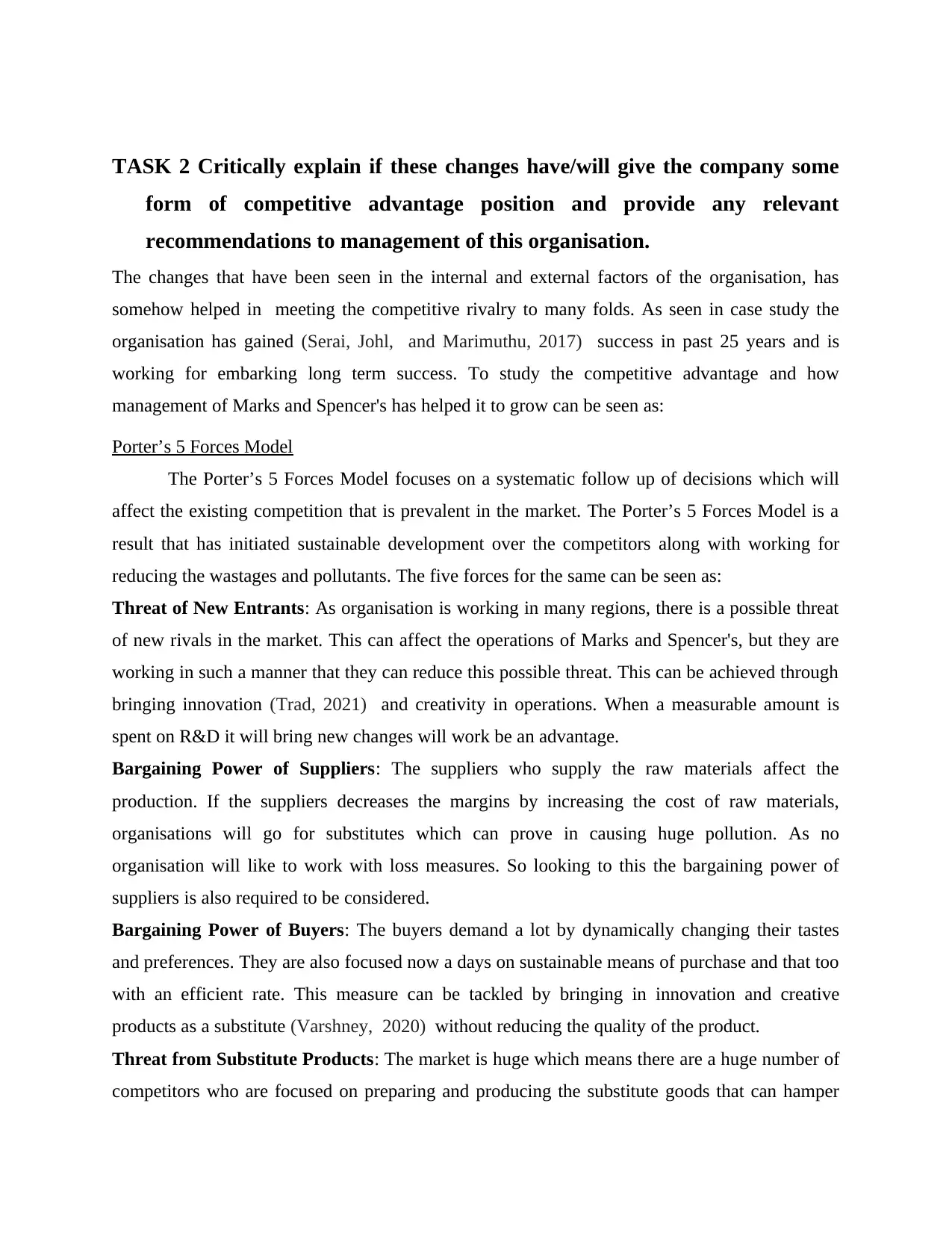
TASK 2 Critically explain if these changes have/will give the company some
form of competitive advantage position and provide any relevant
recommendations to management of this organisation.
The changes that have been seen in the internal and external factors of the organisation, has
somehow helped in meeting the competitive rivalry to many folds. As seen in case study the
organisation has gained (Serai, Johl, and Marimuthu, 2017) success in past 25 years and is
working for embarking long term success. To study the competitive advantage and how
management of Marks and Spencer's has helped it to grow can be seen as:
Porter’s 5 Forces Model
The Porter’s 5 Forces Model focuses on a systematic follow up of decisions which will
affect the existing competition that is prevalent in the market. The Porter’s 5 Forces Model is a
result that has initiated sustainable development over the competitors along with working for
reducing the wastages and pollutants. The five forces for the same can be seen as:
Threat of New Entrants: As organisation is working in many regions, there is a possible threat
of new rivals in the market. This can affect the operations of Marks and Spencer's, but they are
working in such a manner that they can reduce this possible threat. This can be achieved through
bringing innovation (Trad, 2021) and creativity in operations. When a measurable amount is
spent on R&D it will bring new changes will work be an advantage.
Bargaining Power of Suppliers: The suppliers who supply the raw materials affect the
production. If the suppliers decreases the margins by increasing the cost of raw materials,
organisations will go for substitutes which can prove in causing huge pollution. As no
organisation will like to work with loss measures. So looking to this the bargaining power of
suppliers is also required to be considered.
Bargaining Power of Buyers: The buyers demand a lot by dynamically changing their tastes
and preferences. They are also focused now a days on sustainable means of purchase and that too
with an efficient rate. This measure can be tackled by bringing in innovation and creative
products as a substitute (Varshney, 2020) without reducing the quality of the product.
Threat from Substitute Products: The market is huge which means there are a huge number of
competitors who are focused on preparing and producing the substitute goods that can hamper
form of competitive advantage position and provide any relevant
recommendations to management of this organisation.
The changes that have been seen in the internal and external factors of the organisation, has
somehow helped in meeting the competitive rivalry to many folds. As seen in case study the
organisation has gained (Serai, Johl, and Marimuthu, 2017) success in past 25 years and is
working for embarking long term success. To study the competitive advantage and how
management of Marks and Spencer's has helped it to grow can be seen as:
Porter’s 5 Forces Model
The Porter’s 5 Forces Model focuses on a systematic follow up of decisions which will
affect the existing competition that is prevalent in the market. The Porter’s 5 Forces Model is a
result that has initiated sustainable development over the competitors along with working for
reducing the wastages and pollutants. The five forces for the same can be seen as:
Threat of New Entrants: As organisation is working in many regions, there is a possible threat
of new rivals in the market. This can affect the operations of Marks and Spencer's, but they are
working in such a manner that they can reduce this possible threat. This can be achieved through
bringing innovation (Trad, 2021) and creativity in operations. When a measurable amount is
spent on R&D it will bring new changes will work be an advantage.
Bargaining Power of Suppliers: The suppliers who supply the raw materials affect the
production. If the suppliers decreases the margins by increasing the cost of raw materials,
organisations will go for substitutes which can prove in causing huge pollution. As no
organisation will like to work with loss measures. So looking to this the bargaining power of
suppliers is also required to be considered.
Bargaining Power of Buyers: The buyers demand a lot by dynamically changing their tastes
and preferences. They are also focused now a days on sustainable means of purchase and that too
with an efficient rate. This measure can be tackled by bringing in innovation and creative
products as a substitute (Varshney, 2020) without reducing the quality of the product.
Threat from Substitute Products: The market is huge which means there are a huge number of
competitors who are focused on preparing and producing the substitute goods that can hamper
⊘ This is a preview!⊘
Do you want full access?
Subscribe today to unlock all pages.

Trusted by 1+ million students worldwide

the existence of Marks and Spencer's. To work with this the consumer needs are required to be
considered with (Woerkom, and Zeijl-Rozema, 2017) priority and major focus is required to be
made in its resolution. Also the cost is required to be minimal.
Rivalry among the existing players: There are many close competitors and to reduce that
better plans and strategies are required to be formed and executed in a proper manner.
Porters Value chain
This is another systematic and strategic tool which involves five major activities that acts
as cost drivers in reducing the competition and working with an effective pricing strategy. The
activities are concerned as inbound logistics, operations, outbound logistics, Marketing and sales,
and services. Inbound logistics is a traditional method that receives and stores the inputs and
creation of products and (Yap Peng Lok, and Chin, 2019) services. Operations refer to better
consumer experience which can inspire and provide a better and effortless products that will
increase the brand value. Outbound Logistics refers to accumulation of products and services so
that they can be sold and presented in every channel of distribution in an effective manner.
Marketing and sales of the products of Marks and Spencer's is making the consumers aware
about the existing services and techniques which will improve their knowledge. This will make
them aware about the sustainability in the production measures which will give a whole new
outlook. The last is service which is refereed to as the after sales services of the product that is
manufactured and sold in an effective manner so that customers are loyal towards the brand.
CONCLUSION
From the above it can be concluded that in an environment, there are many major threats
which are caused because of the external and internal factors. One such major threat is pollution
and waste management. Being the second largest pollution causing industry, fashion industry has
caused a lot of threats to environment and affected sustenance. Thus in order to reduce the legal
involvement and work with high brand value, the external and internal factors are required to be
studied. These factors have helped Marks and Spencer's to work in view of catering the needs
and demands of environment and also in reducing the wastage by going in sustainability. This
has also reduced the competition in market and enhanced the market operations. The competitive
considered with (Woerkom, and Zeijl-Rozema, 2017) priority and major focus is required to be
made in its resolution. Also the cost is required to be minimal.
Rivalry among the existing players: There are many close competitors and to reduce that
better plans and strategies are required to be formed and executed in a proper manner.
Porters Value chain
This is another systematic and strategic tool which involves five major activities that acts
as cost drivers in reducing the competition and working with an effective pricing strategy. The
activities are concerned as inbound logistics, operations, outbound logistics, Marketing and sales,
and services. Inbound logistics is a traditional method that receives and stores the inputs and
creation of products and (Yap Peng Lok, and Chin, 2019) services. Operations refer to better
consumer experience which can inspire and provide a better and effortless products that will
increase the brand value. Outbound Logistics refers to accumulation of products and services so
that they can be sold and presented in every channel of distribution in an effective manner.
Marketing and sales of the products of Marks and Spencer's is making the consumers aware
about the existing services and techniques which will improve their knowledge. This will make
them aware about the sustainability in the production measures which will give a whole new
outlook. The last is service which is refereed to as the after sales services of the product that is
manufactured and sold in an effective manner so that customers are loyal towards the brand.
CONCLUSION
From the above it can be concluded that in an environment, there are many major threats
which are caused because of the external and internal factors. One such major threat is pollution
and waste management. Being the second largest pollution causing industry, fashion industry has
caused a lot of threats to environment and affected sustenance. Thus in order to reduce the legal
involvement and work with high brand value, the external and internal factors are required to be
studied. These factors have helped Marks and Spencer's to work in view of catering the needs
and demands of environment and also in reducing the wastage by going in sustainability. This
has also reduced the competition in market and enhanced the market operations. The competitive
Paraphrase This Document
Need a fresh take? Get an instant paraphrase of this document with our AI Paraphraser
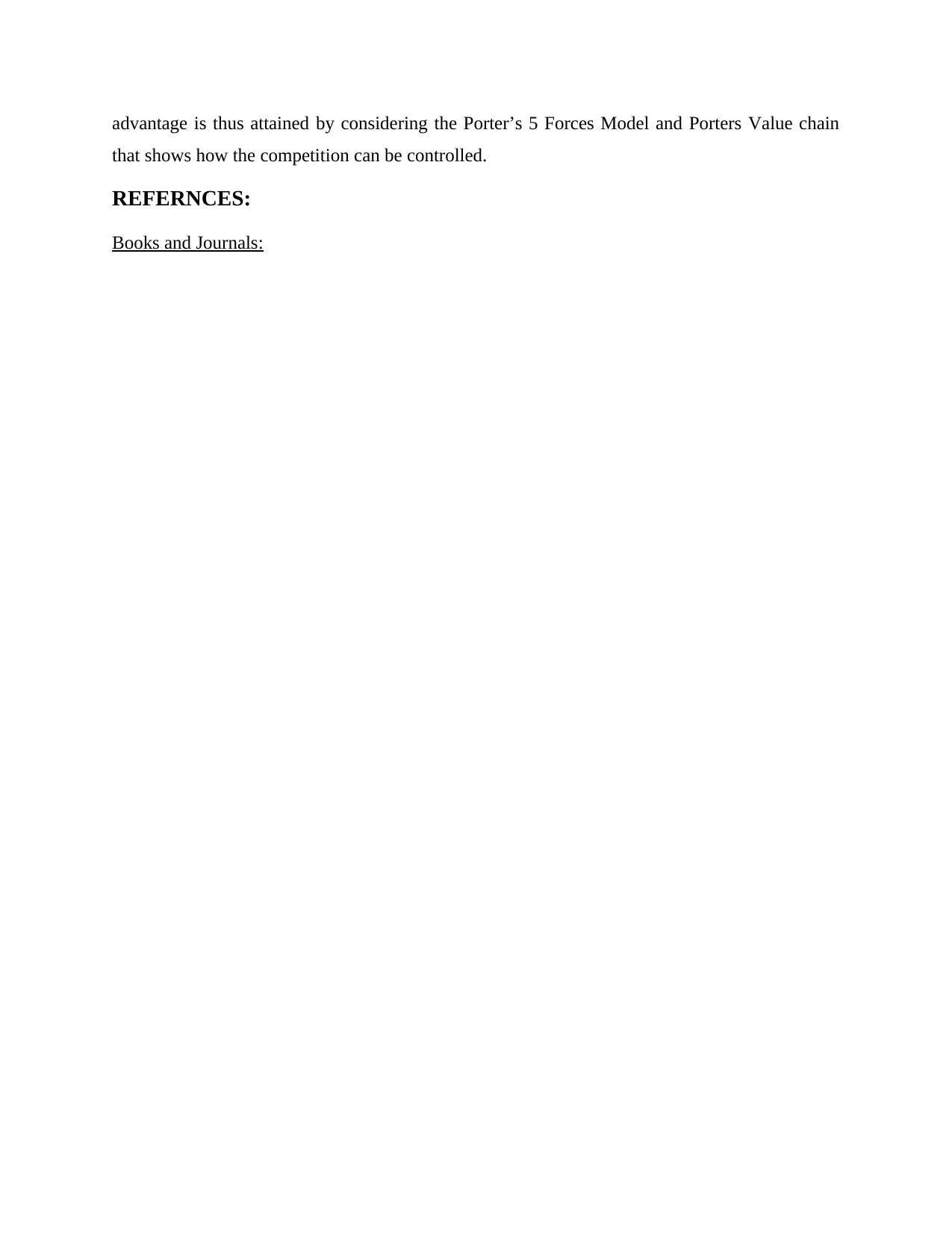
advantage is thus attained by considering the Porter’s 5 Forces Model and Porters Value chain
that shows how the competition can be controlled.
REFERNCES:
Books and Journals:
that shows how the competition can be controlled.
REFERNCES:
Books and Journals:
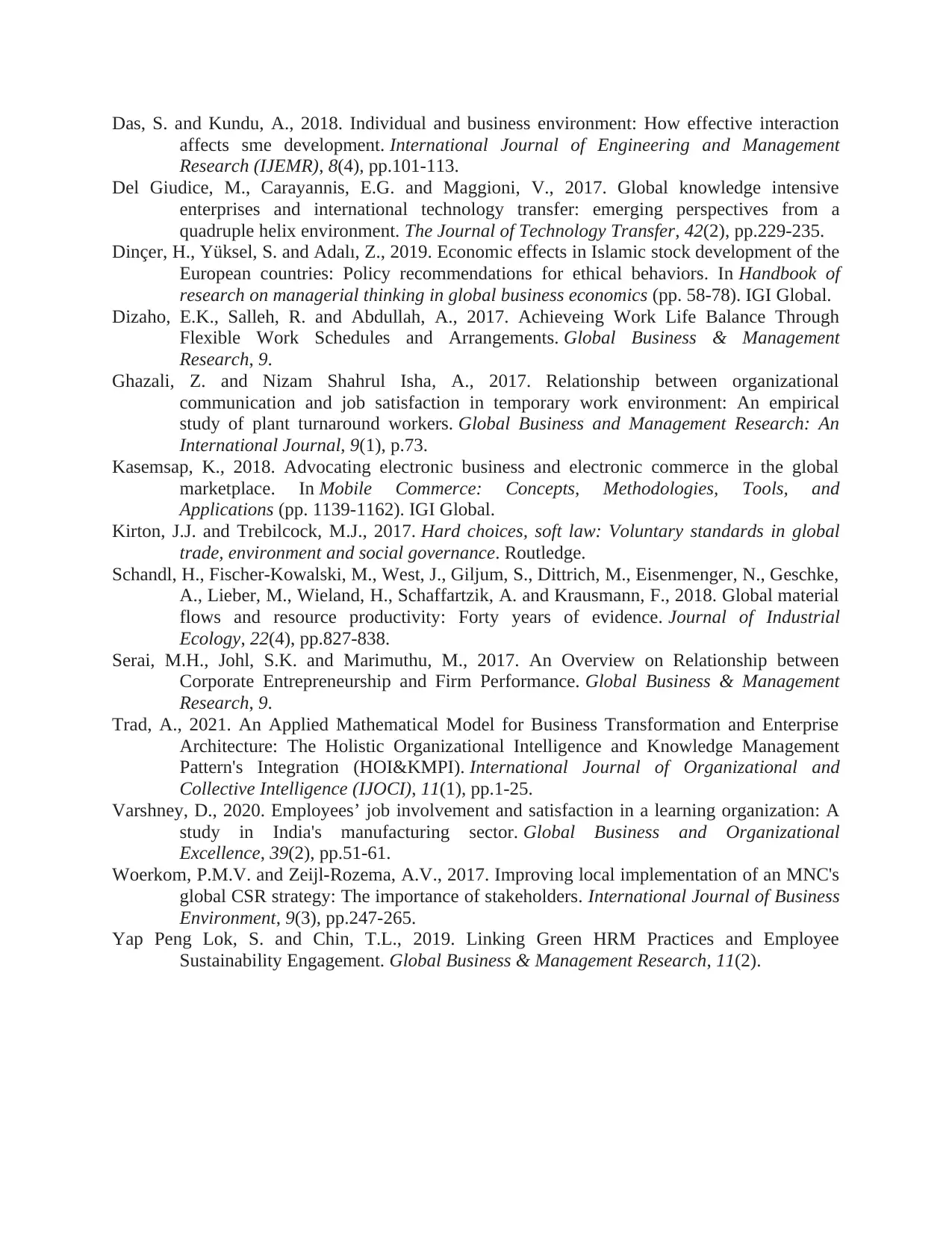
Das, S. and Kundu, A., 2018. Individual and business environment: How effective interaction
affects sme development. International Journal of Engineering and Management
Research (IJEMR), 8(4), pp.101-113.
Del Giudice, M., Carayannis, E.G. and Maggioni, V., 2017. Global knowledge intensive
enterprises and international technology transfer: emerging perspectives from a
quadruple helix environment. The Journal of Technology Transfer, 42(2), pp.229-235.
Dinçer, H., Yüksel, S. and Adalı, Z., 2019. Economic effects in Islamic stock development of the
European countries: Policy recommendations for ethical behaviors. In Handbook of
research on managerial thinking in global business economics (pp. 58-78). IGI Global.
Dizaho, E.K., Salleh, R. and Abdullah, A., 2017. Achieveing Work Life Balance Through
Flexible Work Schedules and Arrangements. Global Business & Management
Research, 9.
Ghazali, Z. and Nizam Shahrul Isha, A., 2017. Relationship between organizational
communication and job satisfaction in temporary work environment: An empirical
study of plant turnaround workers. Global Business and Management Research: An
International Journal, 9(1), p.73.
Kasemsap, K., 2018. Advocating electronic business and electronic commerce in the global
marketplace. In Mobile Commerce: Concepts, Methodologies, Tools, and
Applications (pp. 1139-1162). IGI Global.
Kirton, J.J. and Trebilcock, M.J., 2017. Hard choices, soft law: Voluntary standards in global
trade, environment and social governance. Routledge.
Schandl, H., Fischer‐Kowalski, M., West, J., Giljum, S., Dittrich, M., Eisenmenger, N., Geschke,
A., Lieber, M., Wieland, H., Schaffartzik, A. and Krausmann, F., 2018. Global material
flows and resource productivity: Forty years of evidence. Journal of Industrial
Ecology, 22(4), pp.827-838.
Serai, M.H., Johl, S.K. and Marimuthu, M., 2017. An Overview on Relationship between
Corporate Entrepreneurship and Firm Performance. Global Business & Management
Research, 9.
Trad, A., 2021. An Applied Mathematical Model for Business Transformation and Enterprise
Architecture: The Holistic Organizational Intelligence and Knowledge Management
Pattern's Integration (HOI&KMPI). International Journal of Organizational and
Collective Intelligence (IJOCI), 11(1), pp.1-25.
Varshney, D., 2020. Employees’ job involvement and satisfaction in a learning organization: A
study in India's manufacturing sector. Global Business and Organizational
Excellence, 39(2), pp.51-61.
Woerkom, P.M.V. and Zeijl-Rozema, A.V., 2017. Improving local implementation of an MNC's
global CSR strategy: The importance of stakeholders. International Journal of Business
Environment, 9(3), pp.247-265.
Yap Peng Lok, S. and Chin, T.L., 2019. Linking Green HRM Practices and Employee
Sustainability Engagement. Global Business & Management Research, 11(2).
affects sme development. International Journal of Engineering and Management
Research (IJEMR), 8(4), pp.101-113.
Del Giudice, M., Carayannis, E.G. and Maggioni, V., 2017. Global knowledge intensive
enterprises and international technology transfer: emerging perspectives from a
quadruple helix environment. The Journal of Technology Transfer, 42(2), pp.229-235.
Dinçer, H., Yüksel, S. and Adalı, Z., 2019. Economic effects in Islamic stock development of the
European countries: Policy recommendations for ethical behaviors. In Handbook of
research on managerial thinking in global business economics (pp. 58-78). IGI Global.
Dizaho, E.K., Salleh, R. and Abdullah, A., 2017. Achieveing Work Life Balance Through
Flexible Work Schedules and Arrangements. Global Business & Management
Research, 9.
Ghazali, Z. and Nizam Shahrul Isha, A., 2017. Relationship between organizational
communication and job satisfaction in temporary work environment: An empirical
study of plant turnaround workers. Global Business and Management Research: An
International Journal, 9(1), p.73.
Kasemsap, K., 2018. Advocating electronic business and electronic commerce in the global
marketplace. In Mobile Commerce: Concepts, Methodologies, Tools, and
Applications (pp. 1139-1162). IGI Global.
Kirton, J.J. and Trebilcock, M.J., 2017. Hard choices, soft law: Voluntary standards in global
trade, environment and social governance. Routledge.
Schandl, H., Fischer‐Kowalski, M., West, J., Giljum, S., Dittrich, M., Eisenmenger, N., Geschke,
A., Lieber, M., Wieland, H., Schaffartzik, A. and Krausmann, F., 2018. Global material
flows and resource productivity: Forty years of evidence. Journal of Industrial
Ecology, 22(4), pp.827-838.
Serai, M.H., Johl, S.K. and Marimuthu, M., 2017. An Overview on Relationship between
Corporate Entrepreneurship and Firm Performance. Global Business & Management
Research, 9.
Trad, A., 2021. An Applied Mathematical Model for Business Transformation and Enterprise
Architecture: The Holistic Organizational Intelligence and Knowledge Management
Pattern's Integration (HOI&KMPI). International Journal of Organizational and
Collective Intelligence (IJOCI), 11(1), pp.1-25.
Varshney, D., 2020. Employees’ job involvement and satisfaction in a learning organization: A
study in India's manufacturing sector. Global Business and Organizational
Excellence, 39(2), pp.51-61.
Woerkom, P.M.V. and Zeijl-Rozema, A.V., 2017. Improving local implementation of an MNC's
global CSR strategy: The importance of stakeholders. International Journal of Business
Environment, 9(3), pp.247-265.
Yap Peng Lok, S. and Chin, T.L., 2019. Linking Green HRM Practices and Employee
Sustainability Engagement. Global Business & Management Research, 11(2).
⊘ This is a preview!⊘
Do you want full access?
Subscribe today to unlock all pages.

Trusted by 1+ million students worldwide
1 out of 9
Related Documents
Your All-in-One AI-Powered Toolkit for Academic Success.
+13062052269
info@desklib.com
Available 24*7 on WhatsApp / Email
![[object Object]](/_next/static/media/star-bottom.7253800d.svg)
Unlock your academic potential
Copyright © 2020–2025 A2Z Services. All Rights Reserved. Developed and managed by ZUCOL.




